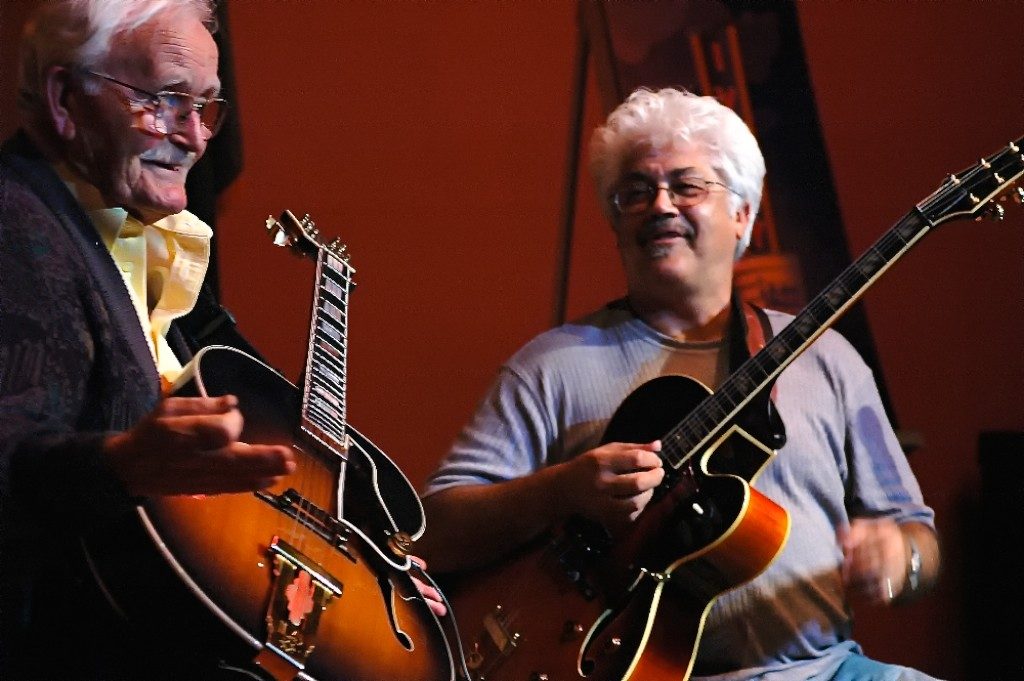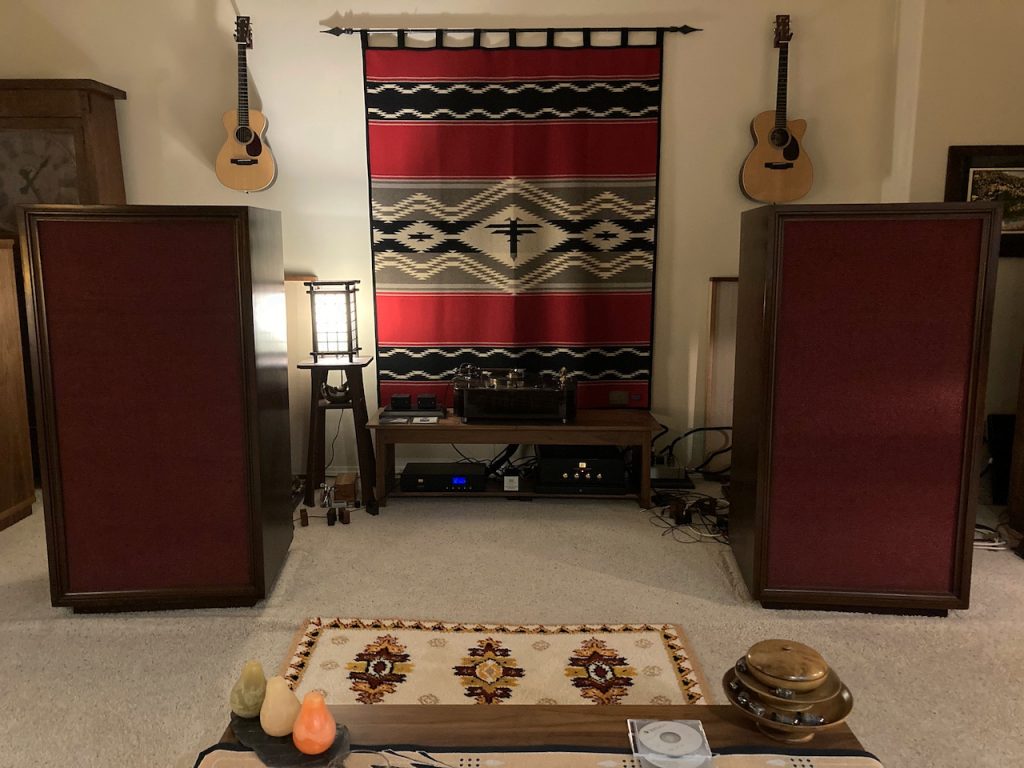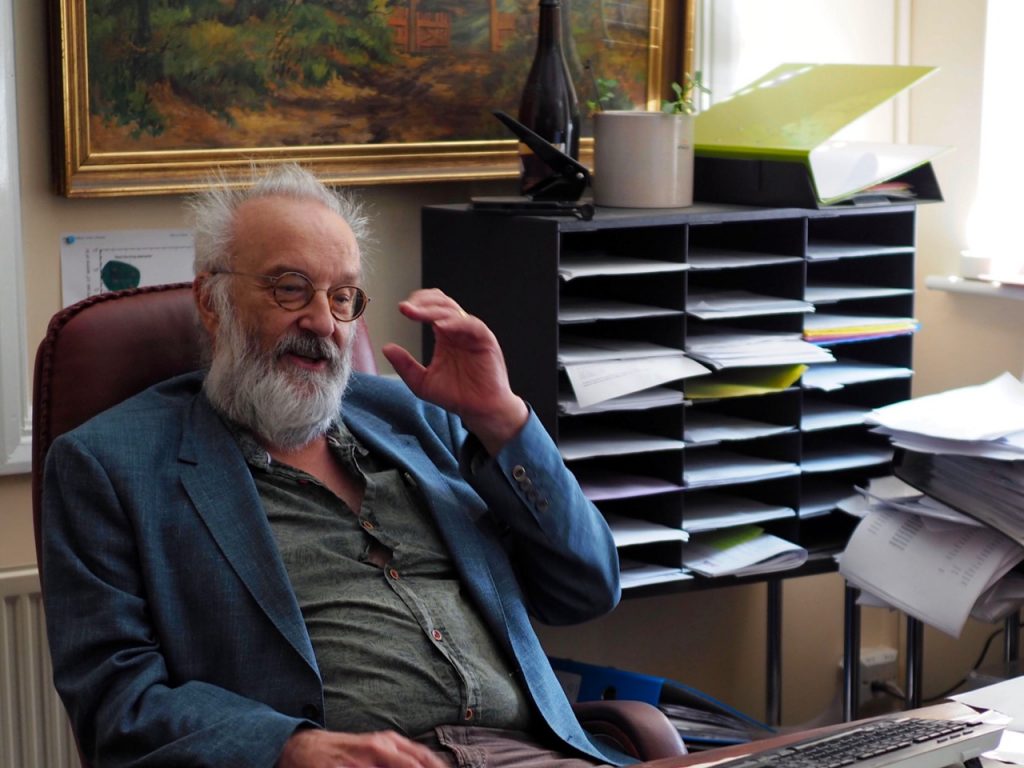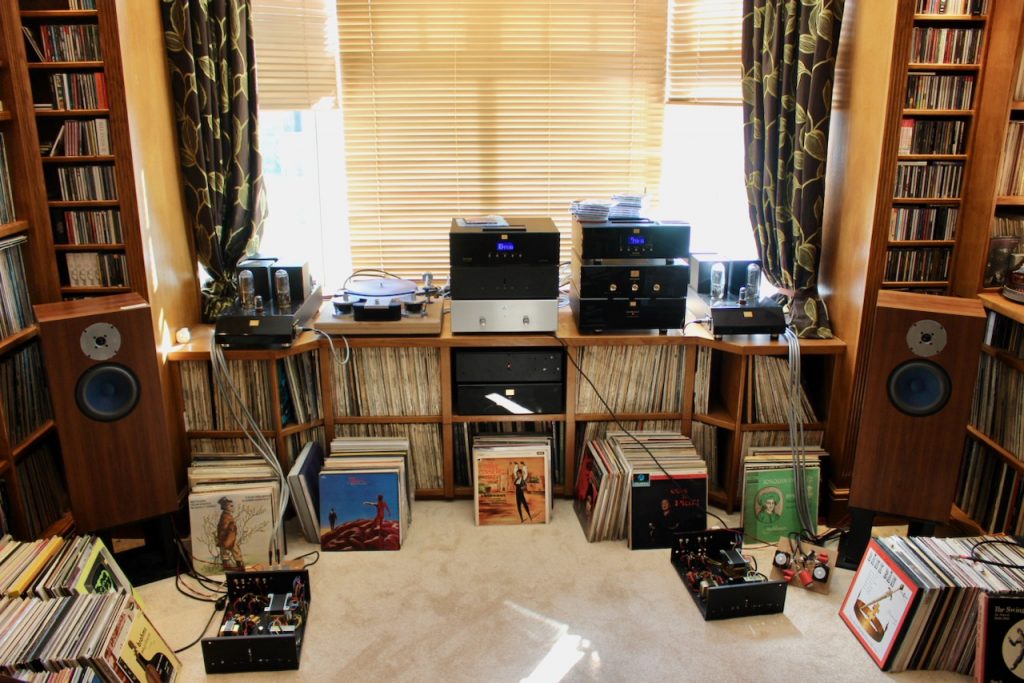Welcome to a new series of informal essays that are meditations about what high-fidelity is, or perhaps could be, in enthusiast audio.
There are a lot of dimensions to exploring high-fidelity in enthusiast audio, but the first question one might ask is, “What does high-fidelity mean in enthusiast audio?”
One possible definition of many is that a high-fidelity audio system is one that reproduces the music with as little alteration as possible.

John La Chapelle & Larry Coryell having fun playing jazz together at Battelle Auditorium. Photo courtesy of Kannan Krishnaswami.
With that definition, the next thoughts that come to my mind are:
- What music are we talking about as our reference for high-fidelity?
- Is it live music (above photo)?
- Is it the sound of the music that is being recorded, whether in the studio or at a live venue?
- Is it a series of reference recordings (photo below)?
- Or is it something else entirely?

Rather than attempting to answer those questions now, I’m going to leave them as open questions, which will hopefully be addressed in adequate depth as this series of essays on high-fidelity unfolds.
Instead, first I want to share my motivations with you for exploring this topic of high-fidelity, and I want to offer you fair warning that the topics discussed may be considered offensive heresy by some, totally obvious to others, but hopefully illuminating for all, and at least useful for understanding different perspectives on this topic.
As a person who writes about enthusiast audio, I want to inform, educate, and entertain readers through what I write.
I am an amateur audio writer, which is to say I don’t make a living from writing about audio, as some others do. I write about audio because I truly enjoy this wonderful hobby of listening to music with good hifi kit, and I want to share the substance of those experiences with others.
However, what I write can affect a rather broad range of people, like the audio enthusiasts who are looking to buy audio equipment, or the local dealer who sells audio equipment, or the people in the industry who build audio equipment for us all to enjoy, so I want to be responsible in what I write so that it is fair and useful to all.
Here’s what I want to get out of this series of essays: I want to learn. I want to better understand what high-fidelity is in the context of enthusiast audio. I want to come up with better ways to communicate the high-fidelity performance of the enthusiast audio equipment I write about for Jeff’s Place and Positive Feedback.
I feel like the vocabulary that has evolved and is used by us audio writers for articulating the performance of enthusiast audio equipment is a hugely limiting factor for me, and yet I’m not entirely sure where to go with that at this point in time.
Most of you reading this will be familiar with the traditional audiophile vocabulary used to describe the performance of an audio component, like transparency (the ability to ‘see’ into the recording), resolution (the amount of detail in the audio signal that is audibly presented), soundstage (the ability to discern the three dimensions of the recorded space in width, height and depth), the soundspace (the ability to convey the acoustic sense of ‘space’ of the recording venue), and imaging (the ability to localize instruments & musicians on the soundstage).
The main concern I have with the traditional audiophile vocabulary is that it tells the reader very little about how well a particular audio system plays music, and how well audio equipment plays music is my reason for being involved in enthusiast audio in the first place.
In fact, by focusing on these non-musical aspects of recordings in our writing (and other aspects I’ll discuss later), we audio writers may be inadvertently damaging the advancement of the audio arts overall, which is of course the last thing we want to do.
To offset the audiophile vocabulary bias, and to shift my assessments of high-fidelity performance back towards the music, I introduced into my writing an assessment of performance based on how well audio components performed reproducing the basic elements of music, like timbre (the unique ‘voices’ of instruments), the resolution of tone color (the ability to distinctly hear the chordal variations resulting from adding additional pitches to three tone triads), melody (the tune you ‘whistle while you work’), harmony (treble & bass accompaniments to the melody), rhythm (the steady beat that determines the tempo), tempo (speed), dynamics (variations in loudness), and loudness (the ability to play naturally at live-like levels appropriate to a piece of music).

However, there is more to music than the aspects mentioned above, as part of the intent of the musicians is to elicit an emotional response in their listeners with their music, so I decided I also wanted to address how well audio equipment connects the listener to the music on an emotional level in my writing.
Researchers who study the neurobiology of music have found there are certain attributes that stimulate emotional responses in the brain while listening to music. Their research suggests that a home music system that can play at realistic loudness levels, is dynamically realistic, and can realistically portray timbral textures, tempo, and beat, will be more emotionally engaging and musically satisfying than a home music system that can’t do those things as well, so I now try to address those aspects in my writing about audio as well.
So, at least up to now, that has been the way I have viewed the world when writing about high-fidelity audio equipment, and what I have tried to relay to readers when I write.

Peter Qvortrup, Audio Note (UK).
Over the last year, I had the opportunity to visit Peter Qvortrup, the proprietor of Audio Note (UK), at his home base just outside of Brighton, England.
We listened to music, and talked about a broad range of subjects, some of which were related to audio and music, and it was truly fascinating and illuminating to hear Peter’s perspectives.
Peter is very knowledgeable about the history of music, recording, and designing audio equipment. Peter has shared perspectives on music and audio with me that have been truly fascinating, definitely illuminating, and I'll be sharing those perspectives with you because I think they're important considerations for everyone to ponder.
It turns out that we have a fairly sizable Venn overlap in our impressions about high-fidelity audio, and particularly for the need of a more useful vocabulary to articulate high-fidelity performance.
To that end, at some point in the future, when international travel becomes safe again from the ravages of the coronavirus, we are planning a weeklong brainstorming session at Peter’s to come up with a more substantive vocabulary to articulate high-fidelity performance than what we see in use today.

Peter's home listening room.
Until we can do our brainstorming session, Peter and I are individually pondering how to better articulate high-fidelity audio performance, and we have been exchanging some ideas to guide us in that endeavor.
We don’t have any of the details worked out yet, but we do have the aforementioned ideas we have been sharing, which I’ll also be sharing with you as the essays proceed.
Be forewarned that our discussions will have an “R” rating, in that the topics discussed may be considered offensive heresy by some, while being totally obvious to others, and hopefully illuminating for all in understanding different perspectives on this topic.
The first installment about our meditations on high-fidelity in enthusiast audio will be coming shortly.
As always, thanks for stopping by, and may the tone be with you!





























